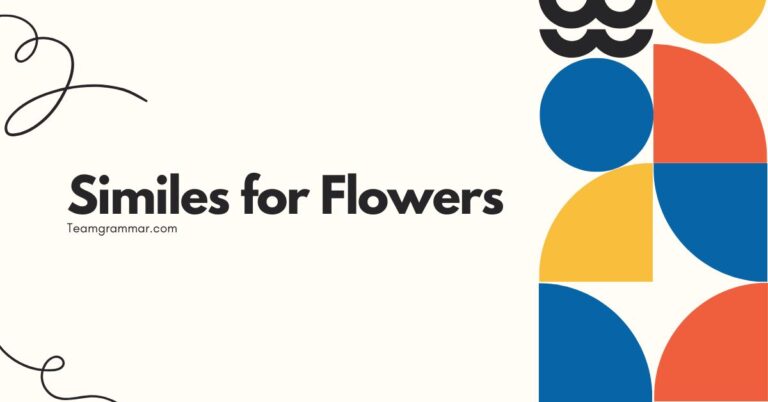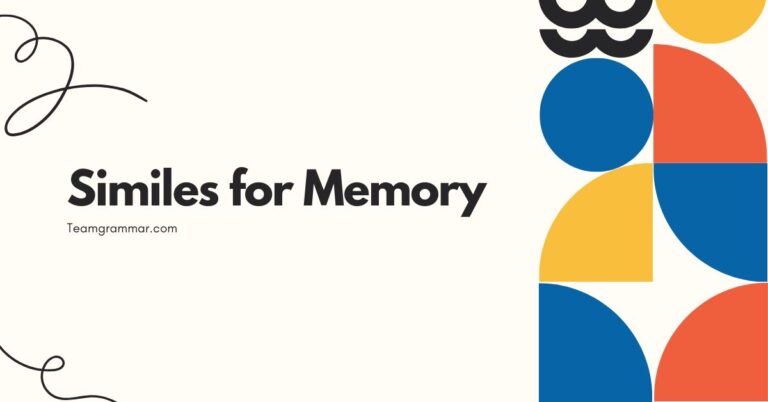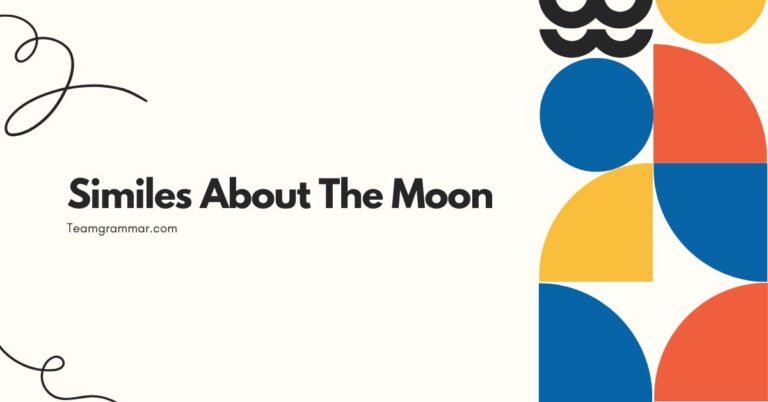39 Similes for Creative Writing: Enhancing Your Prose
Similes are a powerful tool in the arsenal of any creative writer. Understanding and effectively using similes can dramatically enhance your writing, making it more vivid, engaging, and memorable for your readers.
This article provides a comprehensive guide to similes, covering their definition, structure, types, usage rules, common mistakes, and offering practice exercises to help you master this essential literary device. Whether you’re a student, aspiring author, or seasoned writer looking to refine your craft, this guide will equip you with the knowledge and skills to wield similes with confidence and creativity.
Similes are a cornerstone of descriptive writing, allowing writers to paint pictures with words by drawing comparisons between dissimilar things. They enrich the text, making it more engaging and easier for readers to connect with the content.
This guide will help you understand the nuances of simile construction, enabling you to create more impactful and imaginative writing.
Table of Contents
- Definition of Simile
- Structural Breakdown of Similes
- Types of Similes
- Examples of Similes
- Usage Rules for Similes
- Common Mistakes with Similes
- Practice Exercises
- Advanced Topics in Similes
- Frequently Asked Questions
- Conclusion
Definition of Simile
A simile is a figure of speech that directly compares two different things using the words “like” or “as.” The primary function of a simile is to enhance description by creating a vivid image in the reader’s mind. This comparison helps the reader understand an unfamiliar concept by relating it to something familiar.
Similes are commonly used in literature, poetry, and everyday speech to add color, depth, and clarity to communication.
The essence of a simile lies in its ability to illuminate a subject by drawing parallels to something seemingly unrelated. This creates a richer understanding and a more memorable impression.
Similes are not merely decorative; they serve to clarify and amplify the writer’s message.
Structural Breakdown of Similes
The basic structure of a simile consists of three key elements: the subject being described, the linking word (“like” or “as”), and the object to which the subject is being compared. This structure allows for a clear and direct comparison that the reader can easily understand.
Consider the following example: “The warrior wasas brave as a lion.” Here, “warrior” is the subject, “as” is the linking word, and “lion” is the object of comparison. The simile suggests that the warrior possesses the characteristic of bravery, which is commonly associated with lions.
The link word ‘as’ creates the explicit comparison.
Similes are not limited to simple comparisons. They can be expanded to include more details and nuances, providing a more comprehensive picture.
Understanding the core structure is crucial for creating effective and meaningful similes.
Types of Similes
Similes can be categorized based on their complexity and the way they are presented. Understanding these different types can help writers choose the most appropriate simile for their specific purpose.
Simple Similes
Simple similes are the most straightforward type, directly comparing two things using “like” or “as.” They are often used for clarity and ease of understanding. These similes focus on a single point of comparison, making them easily accessible to the reader.
Examples of simple similes include: “She sings like an angel,” “He is as tall as a tree,” and “The snow was like a blanket on the ground.” These similes are clear, concise, and immediately convey the intended meaning.
Extended Similes
Extended similes are more complex and detailed, elaborating on the comparison over several clauses or sentences. They provide a more in-depth exploration of the similarities between the two things being compared.
These similes allow the writer to create a richer and more nuanced image in the reader’s mind.
For example: “The old house stood on the hill, like a forgotten sentinel, weathered and worn by the storms of time, its windows like vacant eyes staring out at the world.” In this extended simile, the comparison between the house and a sentinel is developed over several phrases, creating a more evocative and detailed image.
Implied Similes
Implied similes, also known as metaphors, suggest a comparison without using “like” or “as.” They imply a similarity between two things by substituting one for the other. These similes require the reader to make the connection themselves, adding a layer of subtlety and sophistication to the writing.
For instance, instead of saying “He roared like a lion,” you might say “He roared, a lion.” The direct substitution implies the comparison, leaving it to the reader to infer the similarity in sound and ferocity.
Examples of Similes
Here are numerous examples of similes, organized by category, to illustrate their versatility and effectiveness in creative writing. These examples cover a wide range of subjects and demonstrate how similes can be used to enhance description and evoke emotion.
Similes for Appearance
Similes can be used to describe a person’s appearance in a more vivid and engaging way. By comparing someone’s features to familiar objects or concepts, writers can create a stronger impression on the reader.
The following table provides examples of similes used to describe appearance:
| Simile | Explanation |
|---|---|
| Her eyes were like sparkling sapphires. | This simile compares the color and brilliance of her eyes to the precious gemstone. |
| His hair was as white as snow. | This simile describes the color of his hair, emphasizing its pure white shade. |
| She moved like a graceful swan. | This simile compares her movement to the elegance and fluidity of a swan. |
| He was as thin as a rail. | This simile emphasizes his extreme thinness by comparing him to a narrow rail. |
| Her skin was like porcelain. | This simile describes the smoothness and delicacy of her skin. |
| His smile was like sunshine. | This simile compares the warmth and brightness of his smile to the sun. |
| Her voice was like velvet. | This simile describes the smooth and luxurious quality of her voice. |
| He stood as tall as a giant. | This simile emphasizes his great height. |
| Her dress flowed like water. | This simile describes the fluid and graceful movement of her dress. |
| His beard was like a tangled forest. | This simile describes the unkempt and overgrown nature of his beard. |
| Her laughter was like tinkling bells. | This simile compares the sound of her laughter to the light, clear sound of bells. |
| He walked as slowly as a snail. | This simile emphasizes his slow pace. |
| Her touch was like a feather. | This simile describes the lightness and gentleness of her touch. |
| His gaze was as sharp as a hawk’s. | This simile compares the intensity and focus of his gaze to that of a hawk. |
| Her figure was like an hourglass. | This simile describes her curved and proportionate figure. |
| His face was like a weathered map. | This simile describes the lines and wrinkles on his face, suggesting a life well-lived. |
| Her eyes sparkled like diamonds. | This simile compares the brilliance of her eyes to the precious gemstone. |
| He was as strong as an ox. | This simile emphasizes his great strength. |
| Her hair cascaded like a waterfall. | This simile describes the flowing and abundant nature of her hair. |
| His hands were like leather. | This simile describes the rough and calloused texture of his hands. |
| Her skin glowed like moonlight. | This simile compares the soft, radiant quality of her skin to moonlight. |
| He was as quiet as a mouse. | This simile emphasizes his silent and unobtrusive nature. |
| Her tears fell like rain. | This simile describes the abundance and relentless nature of her tears. |
| His voice boomed like thunder. | This simile compares the loudness and power of his voice to thunder. |
| Her presence was like a breath of fresh air. | This simile describes her refreshing and invigorating effect on others. |
| He was as stubborn as a mule. | This simile emphasizes his unyielding and obstinate nature. |
Similes for Behavior
Similes can also be used to describe a person’s behavior or actions, providing insight into their character and personality. These comparisons can highlight specific traits or tendencies, making the description more compelling.
The following table provides examples of similes used to describe behavior:
| Simile | Explanation |
|---|---|
| He eats like a pig. | This simile describes his messy and gluttonous eating habits. |
| She gossips like a magpie. | This simile compares her constant chatter to the incessant chattering of a magpie. |
| He works like a beaver. | This simile emphasizes his diligence and industriousness. |
| She schemes like a fox. | This simile describes her cunning and devious nature. |
| He follows orders like a sheep. | This simile compares his unquestioning obedience to the behavior of sheep. |
| She nags like a broken record. | This simile describes her repetitive and annoying nagging. |
| He struts like a peacock. | This simile compares his proud and showy behavior to the strutting of a peacock. |
| She pounces like a cat. | This simile describes her quick and decisive actions. |
| He sulks like a child. | This simile compares his moody and resentful behavior to that of a child. |
| She sings like a canary. | This simile describes her cheerful and melodious singing. |
| He fights like a tiger. | This simile emphasizes his fierce and aggressive fighting style. |
| She dances like a leaf in the wind. | This simile describes her graceful and uncontrolled movements. |
| He argues like a lawyer. | This simile compares his persuasive and logical arguments to those of a lawyer. |
| She sleeps like a log. | This simile emphasizes her deep and undisturbed sleep. |
| He runs like the wind. | This simile describes his incredible speed. |
| She watches like a hawk. | This simile compares her vigilance and attentiveness to that of a hawk. |
| He jumps like a frog. | This simile describes his sudden and energetic movements. |
| She listens like a sponge. | This simile compares her ability to absorb information to that of a sponge. |
| He snores like a chainsaw. | This simile describes the loud and disruptive sound of his snoring. |
| She hides like an ostrich. | This simile compares her tendency to avoid problems to the behavior of an ostrich burying its head in the sand. |
| He spreads rumors like wildfire. | This simile describes how quickly and uncontrollably rumors spread. |
| She follows trends like a sheep. | This simile compares her unquestioning adoption of trends to the behavior of sheep. |
| He complains like a stuck record. | This simile describes his repetitive and irritating complaints. |
| She learns like a computer. | This simile compares her ability to quickly process and retain information to that of a computer. |
| He adapts like a chameleon. | This simile describes his ability to change and adjust to different situations. |
| She perseveres like a marathon runner. | This simile compares her endurance and determination to that of a marathon runner. |
Similes for Emotions
Similes can be used to express emotions in a more powerful and relatable way. By comparing feelings to tangible experiences or objects, writers can help readers understand and connect with the emotional state of their characters.
The following table provides examples of similes used to describe emotions:
| Simile | Explanation |
|---|---|
| His heart was like a stone. | This simile describes his cold and unfeeling emotional state. |
| Her joy was like sunshine. | This simile compares her happiness to the warmth and brightness of the sun. |
| His anger flared like a wildfire. | This simile describes the sudden and uncontrollable nature of his anger. |
| Her sadness was like a heavy cloak. | This simile compares her sorrow to a burdensome weight. |
| His fear was like ice in his veins. | This simile describes the chilling and paralyzing effect of his fear. |
| Her hope was like a fragile butterfly. | This simile compares her optimism to something delicate and easily crushed. |
| His love was like a deep ocean. | This simile describes the vastness and depth of his affection. |
| Her grief was like a bottomless pit. | This simile compares her sorrow to an unending void. |
| His excitement was like a bubbling spring. | This simile describes his overflowing and energetic enthusiasm. |
| Her disappointment was like a deflated balloon. | This simile compares her letdown to something that has lost its energy and vitality. |
| His guilt weighed on him like chains. | This simile describes the restrictive and oppressive nature of his guilt. |
| Her loneliness was like a vast desert. | This simile compares her isolation to an empty and desolate landscape. |
| His anticipation was like a coiled spring. | This simile describes his tense and ready state of expectation. |
| Her relief washed over her like a wave. | This simile compares her feeling of release to the overwhelming force of a wave. |
| His jealousy burned like acid. | This simile describes the corrosive and destructive nature of his jealousy. |
| Her peace settled on her like a gentle snow. | This simile compares her tranquility to the soft and calming effect of snowfall. |
| His frustration mounted like a rising tide. | This simile describes the increasing and unstoppable nature of his frustration. |
| Her courage shone like a beacon. | This simile compares her bravery to a guiding light. |
| His rage consumed him like a fire. | This simile describes the destructive and all-encompassing nature of his rage. |
| Her vulnerability was like an open wound. | This simile compares her susceptibility to harm to the rawness of an exposed injury. |
| His confidence soared like an eagle. | This simile describes his high-flying and assured demeanor. |
| Her shame clung to her like a shadow. | This simile compares her embarrassment to a constant and inescapable presence. |
| His confusion clouded his mind like fog. | This simile describes the obscuring and disorienting effect of his confusion. |
| Her determination was like a steel rod. | This simile compares her resolve to something strong and unbending. |
| His despair enveloped him like darkness. | This simile describes the all-consuming and oppressive nature of his despair. |
| Her gratitude flowed like a river. | This simile compares her thankfulness to an abundant and continuous stream. |
Similes for Objects
Similes can be used to describe objects, adding depth and detail to their portrayal. By comparing objects to familiar concepts, writers can create a clearer and more engaging picture for the reader.
The following table provides examples of similes used to describe objects:
| Simile | Explanation |
|---|---|
| The moon was like a silver coin in the sky. | This simile compares the shape and color of the moon to a shiny coin. |
| The car was as fast as a rocket. | This simile emphasizes the car’s incredible speed. |
| The building was like a giant’s toy. | This simile describes the building’s immense size and imposing presence. |
| The book was like a portal to another world. | This simile compares the book’s ability to transport the reader to a different place or time. |
| The computer was like a brain. | This simile describes the computer’s processing power and intelligence. |
| The road stretched like a ribbon. | This simile compares the long and winding road to a narrow strip of fabric. |
| The city was like a beehive. | This simile describes the city’s bustling and energetic activity. |
| The clock ticked like a heartbeat. | This simile compares the steady rhythm of the clock to the human pulse. |
| The painting was like a window to the past. | This simile compares the painting’s ability to evoke a sense of history and nostalgia. |
| The music was like a soothing balm. | This simile describes the calming and comforting effect of the music. |
| The mountain stood like a sentinel. | This simile compares the mountain’s tall and imposing presence to a guard. |
| The fire crackled like laughter. | This simile compares the sound of the fire to cheerful and lively laughter. |
| The darkness was like a blanket. | This simile describes the enveloping and comforting nature of the darkness. |
| The silence was like a heavy weight. | This simile compares the oppressive and unsettling nature of the silence to a burden. |
| The rain fell like tears. | This simile compares the falling rain to the shedding of tears. |
| The stars twinkled like diamonds. | This simile compares the brilliance and sparkle of the stars to precious gemstones. |
| The wind howled like a wolf. | This simile compares the sound of the wind to the mournful cry of a wolf. |
| The waves crashed like thunder. | This simile compares the force and sound of the waves to a powerful storm. |
| The snow sparkled like glitter. | This simile compares the shimmering and reflective quality of the snow to glitter. |
| The fog hung like a shroud. | This simile compares the dense and obscuring nature of the fog to a burial cloth. |
| The river flowed like liquid silver. | This simile compares the smooth and reflective surface of the river to molten silver. |
| The ruins stood like skeletons. | This simile compares the bare and decaying structures of the ruins to skeletal remains. |
| The garden bloomed like a paradise. | This simile compares the beauty and abundance of the garden to a heavenly place. |
| The path twisted like a snake. | This simile describes the winding and curving nature of the path. |
| The bridge arched like a rainbow. | This simile compares the shape and elegance of the bridge to a colorful arc in the sky. |
Similes for Weather
Similes are excellent for describing weather conditions, making them more vivid and relatable. By comparing weather elements to familiar objects or sensations, writers can create a stronger sense of atmosphere and mood.
The following table provides examples of similes used to describe weather:
| Simile | Explanation |
|---|---|
| The rain fell like bullets. | This simile emphasizes the heavy and forceful nature of the rain. |
| The wind howled like a banshee. | This simile compares the eerie and unsettling sound of the wind to the wail of a banshee. |
| The snow was like powdered sugar. | This simile describes the light and fluffy texture of the snow. |
| The fog hung like a ghostly curtain. | This simile compares the dense and obscuring nature of the fog to a spectral drape. |
| The sun beat down like a hammer. | This simile emphasizes the intense and relentless heat of the sun. |
| The sky was like a bruised plum. | This simile describes the dark and ominous color of the sky. |
| The lightning flashed like a strobe light. | This simile compares the rapid and intense bursts of lightning to a strobe light. |
| The thunder rolled like bowling balls. | This simile describes the deep and rumbling sound of the thunder. |
| The ice was like glass. | This simile compares the smooth and transparent surface of the ice to glass. |
| The clouds drifted like cotton candy. | This simile describes the light and fluffy appearance of the clouds. |
| The heat shimmered like a mirage. | This simile compares the distorting effect of the heat to a mirage. |
| The breeze whispered like a secret. | This simile describes the soft and gentle sound of the breeze. |
| The storm raged like a beast. | This simile compares the intensity and ferocity of the storm to a wild animal. |
| The humidity clung like a wet blanket. | This simile describes the heavy and uncomfortable feeling of the humidity. |
| The hail fell like pebbles. | This simile compares the size and hardness of the hail to small stones. |
| The dawn broke like a promise. | This simile compares the hope and new beginnings associated with dawn to a promise. |
| The sunset burned like fire. | This simile describes the intense and vibrant colors of the sunset. |
| The wind cut like a knife. | This simile emphasizes the sharp and biting nature of the wind. |
| The snow piled up like mountains. | This simile describes the height and accumulation of the snow. |
| The sky wept like a mourner. | This simile compares the weeping nature of the sky to someone grieving. |
Usage Rules for Similes
Using similes effectively requires adherence to certain rules. The comparison should be clear and meaningful, and the two things being compared should share a relevant characteristic.
Overusing similes can also diminish their impact, so it’s important to use them judiciously.
1. Clarity:The comparison should be easily understood by the reader.
Avoid obscure or overly complex similes that may confuse or distract from the message.
2. Relevance:The two things being compared should have a logical connection.
The shared characteristic should be apparent and relevant to the description.
3. Originality:While common similes can be effective, strive for originality to make your writing more engaging and memorable.
Avoid clichés and try to create fresh and imaginative comparisons.
4. Moderation:Use similes sparingly to avoid overwhelming the reader.
Too many similes can make the writing feel forced and unnatural.
Common Mistakes with Similes
Several common mistakes can undermine the effectiveness of similes. These include using clichés, creating illogical comparisons, and confusing similes with metaphors.
1. Clichés: Avoid overused similes such as “as busy as a bee” or “as blind as a bat.” These clichés have lost their impact and can make the writing seem unoriginal.
2. Illogical Comparisons:Ensure that the comparison makes sense.
For example, “He was as loud as a whisper” is illogical because whispers are inherently quiet.
3. Simile vs.
Metaphor:Remember that similes use “like” or “as” to make a comparison, while metaphors directly equate two things without using these words. Confusing the two can lead to grammatical errors and unclear writing.
Correct vs. Incorrect Examples:
| Incorrect | Correct | Explanation |
|---|---|---|
| He was as busy as a bee. | He was as busy as a one-armed paper hanger. | The cliché “as busy as a bee” is replaced with a more original and vivid comparison. |
| The sun was like a lightbulb. | The sun was like a furnace. | The comparison to a lightbulb is weak; a furnace is a stronger and more appropriate comparison. |
| She is a rose. | She is like a rose. | “She is a rose” is a metaphor; “She is like a rose” is a simile. |
Practice Exercises
Test your understanding of similes with these practice exercises. Each exercise includes a series of questions designed to challenge your knowledge and improve your ability to create and identify effective similes.
Exercise 1: Identifying Similes
Identify the similes in the following sentences:
| Question | Answer |
|---|---|
| 1. Her voice was like a gentle breeze. | like a gentle breeze |
| 2. The car sped down the highway. | No simile present |
| 3. He was as brave as a lion. | as brave as a lion |
| 4. The snow fell softly on the ground. | No simile present |
| 5. She dances like a dream. | like a dream |
| 6. The old house stood silently on the hill. | No simile present |
| 7. The moon was like a spotlight in the sky. | like a spotlight in the sky |
| 8. He is a rock. | No simile present (metaphor) |
| 9. The water flowed like liquid glass. | like liquid glass |
| 10. The children laughed with glee. | No simile present |
Exercise 2: Completing Similes
Complete the following similes with appropriate endings:
| Question | Answer |
|---|---|
| 1. He was as tall as _____. | a tree |
| 2. She sings like _____. | an angel |
| 3. The food tasted like _____. | heaven |
| 4. He ran as fast as _____. | the wind |
| 5. The room was as cold as _____. | ice |
| 6. Her eyes shone like _____. | stars |
| 7. The silence was as deep as _____. | space |
| 8. He slept like _____. | a log |
| 9. The world is like _____. | a stage |
| 10. She smiled like _____. | sunshine |
Exercise 3: Writing Similes
Write your own similes to describe the following subjects:
| Subject | Example Answer | |
|---|---|---|
| 1. A rainy day | The rain fell like tears from the sky. | |
| 2. A crowded room | The room was as packed as a can of sardines. | |
| 3. A fast car | The car sped off like a bullet from a gun. | |
| 4. A beautiful sunset | The sunset was like a painting splashed across the sky. | |
| 5. A difficult task | The task was as challenging as climbing Mount Everest. | |
| 6. A gentle touch | Her touch was as | soft as a feather. |
| 7. A loud noise | The noise was like a thunderclap in a quiet room. | |
| 8. A calm sea | The sea was as still as a mirror. | |
| 9. A dark night | The night was as black as ink. | |
| 10. A warm fire | The fire was like a comforting embrace on a cold day. |
Advanced Topics in Similes
For advanced writers, exploring the nuances of similes can lead to more sophisticated and impactful writing. This includes understanding how to use similes in combination with other figures of speech, and how to tailor similes to fit specific contexts and audiences.
1. Combining Similes with Metaphors:Using similes and metaphors together can create a richer and more layered description.
For example, you might start with a simile to introduce a comparison, and then follow with a metaphor to deepen the connection.
2. Tailoring Similes to Audience:Consider your audience when crafting similes.
A simile that resonates with one audience may not be effective for another. Use references and concepts that are familiar and relevant to your readers.
3. Subverting Expectations:Sometimes, the most effective similes are those that challenge the reader’s expectations.
By using unexpected or unconventional comparisons, you can create a more memorable and thought-provoking image.
Frequently Asked Questions
Conclusion
Similes are a valuable tool for any writer looking to enhance their descriptions and engage their readers. By understanding the structure, types, and usage rules of similes, you can craft more vivid, memorable, and impactful writing.
Practice these techniques, avoid common mistakes, and strive for originality to master the art of the simile. With dedication and creativity, you can use similes to bring your writing to life and captivate your audience.







